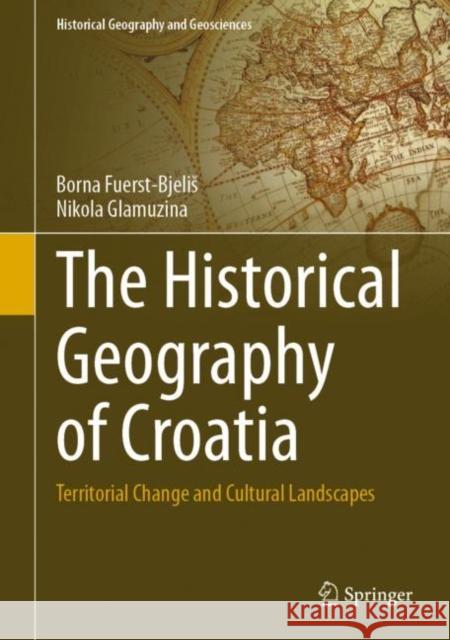The Historical Geography of Croatia: Territorial Change and Cultural Landscapes » książka



The Historical Geography of Croatia: Territorial Change and Cultural Landscapes
ISBN-13: 9783030684327 / Angielski / Twarda / 2021 / 203 str.
The Historical Geography of Croatia: Territorial Change and Cultural Landscapes
ISBN-13: 9783030684327 / Angielski / Twarda / 2021 / 203 str.
(netto: 576,41 VAT: 5%)
Najniższa cena z 30 dni: 578,30
ok. 22 dni roboczych
Bez gwarancji dostawy przed świętami
Darmowa dostawa!
Introduction
1. Croatia — territory and the process of bordering
2. An outline of the environment
3. Prehistory - the beginnings of the human-environmental relations
· Paleolithic - the first human-environmental interactions prior to the Holocene
· Development and defining of the first settlement zones in the Neolithic
· Geographic origins of Indo-European migrations· Environmental priorities in the Eneolitic: mountains and hill fortresses
4. Antiquity - the first model of the territorial organization
· The spatial impact of the Ancient Greek colonization
· Ancient Roman civilization as a turning point in the modeling of cultural landscape
o Urban network as a main holder of spatial organization
§ Town and ager — the functional whole
o Transportation system as the element of spatial organization and transformation· Administrative organization as the element of spatial transformation
· The geographic heritage of the Roman Antiquity
5. Early Medieval Croatian state - spatial organization and
new cultural landscape
o De-urbanization and declension of Roman cultural landscape
o Historical-geographical implications of Slavic colonization
o Primary geopolitical nucleus and territorial organization in the context of new environmental values
o Beyond the nucleus - conceptualization of Croatian historical regions
o Comitatus - primary territorial unito Pagania – integration of borderland principalities
o Landscape change - duality of Adriatic and continental Croatia
o Population change as the consequence of Slavic colonization
6. Middle Ages - economic and political stabilization, re-urbanization and regional differentiation
o New geopolitical nucleus and development of the geographic concepts of Croatian regions
o Slavonia - Urban and transportation network as indicator of political and economic changeo Adriatic Croatia
o Dalmatia - the change of spatial concept; urban and economic continuity
§ Venetian Republic – The impact of the emerging power on the spatial, economic and political relations in the Adriatic
o Dubrovnik
o Istria - politically and culturally contact area
7. Historical-geographical developments of the neighboring lands in the Middle Ages
o Geographical nucleus and spatial developments of the Bosnian stateo Medieval Serbia
8. The Ottoman conquests and its impact on the territorial reduction and spatial change
o The medieval European feudal crisis as a prerequisite of the spatial disintegration
o The general setting of the Ottoman conquest in the European space
o Croatian lands under Ottoman rule
o Territorial organization of the Ottoman Croatia
o The impact of the Ottoman conquest on the development of the spatial concepts of Croatian regions
o Elements of the new cultural landscapeo Urban development: oriental-Islamic town
o Croatian borderlands
o Migration flows as a consequence of the Ottoman conquest
o Wallachians/Morlachs – people and the territory
9. Early Modern Ottoman retreat
o Internal degeneration of the Ottoman state
o The prosperity of the Christian Europe
o Military Border – new territorial entity
o Cultural landscape change in the Military Border and civil Croatian territories
o Ottoman territorial retreat and development of new borders
o New Pannonian-Adriatic developmental axis and its implication on cultural landscape of Slavonia and Military Border
o Cultural landscape of Dalmatia – an indicator of Venetian politics
o The impact of the land reform on migration and cultural landscape of the Venetian Aquisto Nuovo
o Manufacture, transportation and commerce
o Populationo Urban network
o Population and settlement change as a consequence of the Ottoman territorial retreat
10. Spatial impacts of the industrial development within the Austro-Hungarian Monarchy
o Political-geographical context of change
o Political and regional divide within the Austro-Hungarian Monarchy
o Railway networks – implication of the three concepts on the territory of Croatia
o Austrian railway networko Hungarian railway network
o Bosnian-Herzegovinian narrow-gauge railway network
o Industrialization, urbanization and regional differentiation of the economic development
o Croatia proper (under direct Croatian Ban’s rule)
o The impact of political-geographical marginality on the development of Istria and Dalmatia
o Industrial urban network
o Population – great migration waves
11. Croatia within the South-Slavic political associations
o Croatia within the Yugoslav Monarchy – agrarian land with continental economic orientation
o Integration and disintegration processes
o Transportation significance of Croatia within the South-Slavic state
o Economic-geographic development
o New developments and hierarchy of urban network
o The transformation of the spatial structure of Croatia within the socialist Yugoslavia
o Political-geographical integration processes
o After second-world war restoration and development
o Population flows
o New urban network – the foundation of the nodal regional structureo Cultural landscape change
o Spatial implication of the new administrative organization
12. Developmental tendencies of Croatia since the 90-es
o Political-geographical context of change
o Geographical dimensions of the war
o Geographical dimensions of the economic transition
o The change of administrative organization
o Urban network development tendencies and change in gravitational and nodal relations
o Integration processes and their implications on economic development and quality of life
This monograph gives a comprehensive but in-depth analysis of the territorial development of Croatia and historical processes of significant spatial impact. It covers the millennial time span – from prehistory till the present, through relevant periods, e.g., prehistory, antiquity, Middle Ages, period of Ottoman progression and retreat, Post-Ottoman period of development of the Middle European railway network, the period of South Slavic political associations (old and new Yugoslavia), and the post-Yugoslav period of independent Croatia.
1997-2025 DolnySlask.com Agencja Internetowa
KrainaKsiazek.PL - Księgarnia Internetowa









